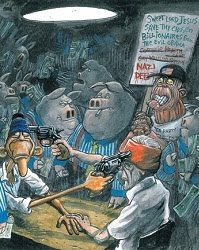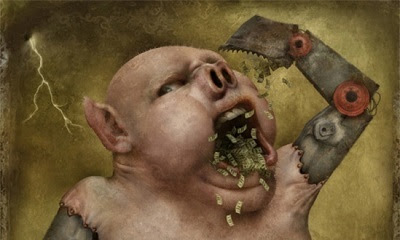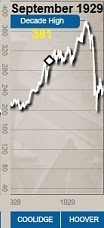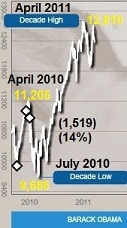Up, Down, Appendices, Postscript.
There's sine qua non - 'that without which there is nothing,' the indispensable and essential ingredient, or the raison d'être maybe. But what is the opposite Latin nomenclature I wonder? 'That with which there is nothing.' (Nevermind the subtle impossibility of such a state.) Could it be cum qua non? The 'cum' gives it a certain Fugs flavour ... and I like that.

 A few recent frames from Martin Rowson. 'Broad, sunlit uplands' comes from a 1940 speech by Winston Churchill: Their Finest Hour.
A few recent frames from Martin Rowson. 'Broad, sunlit uplands' comes from a 1940 speech by Winston Churchill: Their Finest Hour.The cum qua non I am thinking of at first is billionaires: H. grǽdum, from old Anglo-Saxon grǽd, but I like the 'gray-dumb' homonym too.
A-and for background music I put this playlist together: of Mike Oldfield, The Penguin Café Orchestra, Samuel Barber's Adiago for Strings
 (soppy maybe, but it could have been worse - in a fit of kitchen-sink-ism I nearly threw in the New World Symphony as well), and finishing up with more Mike Oldfield as he echoes Michael Praetorius à la Ezra Pound.
(soppy maybe, but it could have been worse - in a fit of kitchen-sink-ism I nearly threw in the New World Symphony as well), and finishing up with more Mike Oldfield as he echoes Michael Praetorius à la Ezra Pound.  |
All this idle chitter-chatter about the U.S. 'Debt Ceiling' and hardly a word about billionaires? The left-libs trash-talk the Tea Partiers for not understanding Keynesian economics, for being 'stupid,' but it seems to me that living humbly within your means is an ideal that might even ... begin to heal the environment(?).
As if the left-libs know (or can even see) anything beyond their own umbilical entitlements. Left-libs, and fat cats too, take note: as one gets fatter and fatter, the abdominal musculature thins and weakens, and umbilical hernias become more likely and frequent.
Two more Matt Mahurin images - these are thumbnails, click on them to see entire:
  |   |
Nor are all the rapists men - Obama's billionaire beneficiaries are not operating in sexual terms are they? They will do anyone, regardless of race creed sex age - what-fucking-ever! A-and there are lots of female billionaires out there, not all of it inherited - Alice Walton, Abigail Johnson, Anne Chambers ... and more aspiring ... So.
(When I think about Caetano I want to hear Terra. Here are three versions: 2008 maybe, and this and this from the late 70's I think. You can find the lyrics with a translation here.)
Yes, rape: that mélange of inside-out inverted sex, power, greed, violence, insecurity ... that's what's goin' on. And sure as fuck'n be'jeesus there's worse comin'.
"Winter is icumen in, lhude sing Goddamm."




 The Spur, 164 Water Street, St. John's - I spent some time there over the years reading my paper in the afternoon over a couple or three double Jameson's.
The Spur, 164 Water Street, St. John's - I spent some time there over the years reading my paper in the afternoon over a couple or three double Jameson's.Then last week I got invited to the book release of God Help Thee: A Manifesto by Joel Thomas Hynes. I couldn't go, but you can watch part of the performance here.
I saw Pius Power Jr. deliver a similar rant (at very close range) directly into the face of the local MHA (Member of the House of Assembly) one afternoon, Murphy I think the guy's name was, chased 'im right off a wharf in South East Bight where he was stumping for votes, scuttled down the risins like a rat he went and back away in his float plane ... and it still warms my heart to think of it.
The title God Help Thee is probably a reference to the last verse of the Ode to Newfoundland which goes:
As loved our fathers, so we love,
Where once they stood, we stand.
Their prayer we raise to Heaven above,
God guard thee, Newfoundland;
God guard thee, God guard thee, God guard thee, Newfoundland.
You can listen here to Anita Best singing it.
 Not knowing anything about the guy, I got Right away Monday, his 2007 novel. I had a little trouble getting started ... BUT ... The Spur began to figgure into it (!) - a denizen of The Spur with lots of shit to pour out upon both the head & the feet (and everything inbetween) of George Street can't be all bad - so I soldiered onwards. In the end the book was a silliness to me, but I am happy for him. He's gotten a place up in Trinity Bay out of it apparently - right handy to the yuppy cinema village I'll wager. All good.
Not knowing anything about the guy, I got Right away Monday, his 2007 novel. I had a little trouble getting started ... BUT ... The Spur began to figgure into it (!) - a denizen of The Spur with lots of shit to pour out upon both the head & the feet (and everything inbetween) of George Street can't be all bad - so I soldiered onwards. In the end the book was a silliness to me, but I am happy for him. He's gotten a place up in Trinity Bay out of it apparently - right handy to the yuppy cinema village I'll wager. All good.His other one, Down to the Dirt from 2004 is coming eventually. I watched the movie in the meantime which ... seemed to run in a closed circle (?) ... more to say when I have read the book maybe ... [I've read it, more of the same, like he says himself, if you can sell words by the pound then ... why not?]
You can locate a Newfoundlander within his or her culture on how she or he deals with the 'Screech In' ritual (which is recently invented & entirely bogus, the cum qua non as it were). Here's Hynes' take on it, expressed through one of his characters, Monica, here it is. You can read this very carefully and still not know exactly what Joel Hynes thinks about it. He doesn't 'fuck' it in his manifesto either as far as I can remember. Attaboy (I guess). Keep 'em guessin'. Or maybe it's one'a them whatchamacallit ... cognitive dissonance things ... Or maybe ... 'e just don't know.
The use of the second person singular pronoun 'thee' takes us two ways: The first (and original) is a track running parallel to the French tu and Portuguese ti connoting familial intimacy - even asking the question "Voulez vous me tutoyer?" shows that a watershed moment is underway; and the second goes in the opposite direction through the KJV, or out of it at least, and brings on sacred and formal overtones. The intimate use has disappeared entirely from English except once or twice in Lady Chatterley's Lover (but that was years ago); has mostly gone from Portuguese, in Brasil at least; and was current in French when I learned it in the 60's but I can't say what goes on now. The rise of secularism would seem to indicate that all of these forms, along with the intimate and the sacred realms they belonged to, are entirely doomed ... Who can say? (The Pope?)
The Ode to Newfoundland is still regularly sung in public - all is not lost.
As for Anglo-Saxon antidotes to grǽd, I'm good with these few bits from Thomas Pynchon's Gravity's Rainbow.
People seem to like to talk that Scanlan's has new toilets. Hynes makes a big deal about the smelly toilet in The Spur in his book. I never had a problem with it. I sez, "Fuck yer toilets!"
 Another month's bar on the FAO Food Price Index and the level trend continues, a plateau. I thought it was the monthly Food Price Monitor that carried this particular coloured graph, it is definitely in the Food Outlook but that's biannual (?).
Another month's bar on the FAO Food Price Index and the level trend continues, a plateau. I thought it was the monthly Food Price Monitor that carried this particular coloured graph, it is definitely in the Food Outlook but that's biannual (?).So, six months of the highest food prices ever, bad enough.
The recent FAO report: Price volatility and food security tells me that "Biofuel support policies in the United States and the European Union have created a demand shock that is widely considered to be one of the major causes of the international food price rise of 2007/08," which you can see on the chart. 'Biofuel support policy' is a euphemism for 'subsidy.' Subsidies in Europe & North America amount to tax dollars, taken from the rich-enough-to-pay-taxes, given to the too-rich-to-pay-taxes, and used to increase the misery and decrease the life-spans of the truely poor who pay taxes in kind, in what a friend of mine used to call 'human coin' meaning time - in denominations of minutes, days, months, years of life.
But I am a crazy-man at this point, twisted - I like finding evidence of callous rich-country connivance in global misery. A more balanced and intelligent analysis of the report comes from Jayati Ghosh. As she repeats to us, it's not just biofuels, it is also 'speculative forces' aka commodities trading. And she also points out what it is not - it is not, as conventional wisdom holds, increased buying power in the emerging Chinese & Indian middle classes.






 Ten million people at risk of starving to death in the Horn of Africa, Ethiopia & Somalia & Kenya. Half a million in Dadaab camp alone.
Ten million people at risk of starving to death in the Horn of Africa, Ethiopia & Somalia & Kenya. Half a million in Dadaab camp alone.Al-shabaab soldiers carrying guns. Kenyan soldiers carrying guns. Razor wire. Colour-coded wrist bands. Children with yellow hair - 'kwashiorkor' a Ghanian pun meaning 'red or yellow haired boy' and 'the dispossessed,' look at him (or her maybe), second from the left - a symptom of an extremely protein deficient diet (which includes no diet at all).
And all I can do is bone up on my geography - Google Maps is a sub-standard tool but it's there - here's my map.
Here, take another look at this kid, a girl the caption says so that's cleared up. Those eyes are lookin' right atcha eh? Here, look at all of 'em bedad. Y'all think I'm sitting here wringing my hands? Cuz I'm not. 'On the brink' they call it - that's just the way they talk in Boston.
Food for thought, or a process, or ... something:



 These graphs come from the 'Resource Center / Interactive Learning Center' tab on the Dow Jones website. There is also a large poster (.pdf) which tells the story in more detail up to 2008, sort of.
These graphs come from the 'Resource Center / Interactive Learning Center' tab on the Dow Jones website. There is also a large poster (.pdf) which tells the story in more detail up to 2008, sort of.Why put each graph on a different y-axis? Why not calculate %'s? Percent is relevant isn't it? One wonders if the real intention of this 'Learning Center' is clarification or obfuscation? Or possibly just myth enhancement (as they say in the Viagra adverts). Anyway ... you would think that it might be useful, it should be useful ... BUT ...
Looking into it on Wikipedia: the Dow Jones Industrial Average, and then the Dow Divisor.
When it began, the index was simply the average value in $US of a representative basketful of stocks, and a 'point' was one $US. But things change over time - stocks split for example, the specific stocks included in the basket change, and so on - so the simple average has to be modified by the Dow Divisor, and the equation which is used: sum of the old Stocks / old Divisor = sum of the new Stocks / new Divisor; to keep the index the same over these changes - basically turns it into a comparison of apples and oranges, nothing but (yet another) confidence trick, a shell game.
Bollocks! ... Too harsh? It works as long as you trust the wizards behind it. But who trusts 'em? Standard & Poor's f'rinstance - trust 'em? Lehman's was rated A (with a distinctly complicated rationale here) until a week before it failed. Now they have downgraded US Treasury Bonds to AA+ - does it mean anything or are they just giving Obama paddywhacks? ... Don't mean sheeit.
 Here Titanic, try this on:
Here Titanic, try this on:Northrop Frye liked this stuff apparently: E.J. Pratt The Titanic. Maybe they were friends. Here's the end of it (the tip - so to speak):
And out there in the starlight, with no trace
Upon it of its deed but the last wave
From the Titanic fretting at its base,
Silent, composed, ringed by its icy broods,
The grey shape with the palaeolithic face
Was still the master of the longitudes.


 The tip of the Petermann Glacier broke off last August. A year later and it is sailing down the Labrador coast, coming up on the Straits of Belle Isle. A journey of 2,000 miles and more. Still three miles across - the size of Manhattan - and I can't think of a more apt comparison.
The tip of the Petermann Glacier broke off last August. A year later and it is sailing down the Labrador coast, coming up on the Straits of Belle Isle. A journey of 2,000 miles and more. Still three miles across - the size of Manhattan - and I can't think of a more apt comparison.

 They all imagine that they have their traces on this one - radio beacons up the yin-yang, satellite photographs, a nomenclature and a name for every piece - PII-A & PII-A-a and such like (the II distinguishes the 2010 island from a previous one in 2008). A fisherman from Battle Harbour took this video.
They all imagine that they have their traces on this one - radio beacons up the yin-yang, satellite photographs, a nomenclature and a name for every piece - PII-A & PII-A-a and such like (the II distinguishes the 2010 island from a previous one in 2008). A fisherman from Battle Harbour took this video.No b'y, I wants the height not the width! An' waddabout Ragnarök?
  |
(It all started years ago with a movie I remember in which John Wayne talks to an invisible ex-girlfriend named Tex - except that nowhere can I find any reference to any such movie.)
Neither do I have any idea where my Anima Preta is or comes from (yes, I'm betting she's a girl), or what language she might speak - beyond the elemental memes of gaze, glimpse, & glance.
"I will show you fear in a handful of dust," wrote (beware of pop-ups!) Eliot in 1922, "Wo weilest du?" / Where do you dwell? ... though as often with Eliot I have no exact idea of what he meant. Is the 'du' there equivalent to the du in Martin Buber's 'Ich und Du' / I and Thou? Which would make it 'Where dost thou dwell?'
The story of Jacob & Esau comes to mind for some reason. Selling out for a 'mess of pottage' (thinking of a house in Trinity, that must be it). But no more than the bog-standard human condition is it? Wikipedia gives me:
"Thou sold'st thy birthright, Esau! for a mess;
Thou shouldst have gotten more, or eaten less;"
Who cares if Newfoundland culture has been boiled down to a Screech In ritual with no antecedents? It doesn't matter - the whole shebang has been sold & bought - so bring it on! Bring on yer mess of pottage b'y! And an iceberg chaser!
 But Lord Byron was lame at birth, which he didn't like at all. What would he have done for a new right foot I wonder? Conjures up echoes of Sylvia Plath's Daddy - a shoe being involved and so much of it rhyming with 'du'.
But Lord Byron was lame at birth, which he didn't like at all. What would he have done for a new right foot I wonder? Conjures up echoes of Sylvia Plath's Daddy - a shoe being involved and so much of it rhyming with 'du'.Scheherazade's customary opening, "O auspicious King," and Kipling's "O my Best Beloved," contain for me an implicit subjunctive, a wish or a possibility or a 'this may be so or something like it,' establishing a kind of 'thou' relation as Buber might call it. What better way to begin any story than to fold the listener gently into an entirely voluntary and contingent and temporary ... communion? And who knows exactly how long temporary is?
Be well gentle reader.
 Postscript: (or Errata or Last-minute Shit, whatever)
Postscript: (or Errata or Last-minute Shit, whatever)Got that right:
I find it passing strange that with all the discussion in Toronto, about closing libraries that the closing of hockey arenas has not been discussed. Perhaps, we could have a debate between Margaret Atwood and Don Cherry about the relative merits of arenas and libraries. It would be more fun than roller derby.The cartoon is from a recent Doonesbury series on Elizabeth Warren, mother-son relationships, fantasies and so on - worth a look.
Graham Steeves, Port Elgin, Ontario.
Appendices:
1. The truth about the global demand for food, Jayati Ghosh, August 2 2011.
The truth about the global demand for food, Jayati Ghosh, August 2 2011.
A new report from the FAO blows the myth about increased grain consumption from developing countries leads to higher global demand and higher prices
Ever since the global food crisis of 2007-08, a perception has persisted in many parts of the world that one of the main underlying reasons for the price spikes in major food items – especially food grain – is the increased demand from countries such as China and India. If anything, this perception has become even more widespread since prices started rising again, especially since early 2010.
On the face of it, such a perception seems quite reasonable. After all, China and India both have huge populations, accounting for nearly 40% of the total world population between them. Their economies have both been expanding very rapidly, much faster than most of the rest of the world, so per capita incomes have been rising from relatively low bases. It is well known that as incomes rise from low levels, people tend to consume more food grain – not necessarily directly, but indirectly through the consumption of livestock products that require more grain in the form of food.
So it is only to be expected that the increased incomes in China and India would translate into more demand for food grain, and this could certainly affect the global supply demand balance in ways that would cause food prices to rise. Expected, yes: but did this actually happen?
It turns out that there has been barely any change, and if anything a slowdown, in the rate of grain consumption in these two large countries. And the global consumption of grain for all food purposes has actually decelerated in recent years compared with previous periods.
This is very evident from an important new report from the high level panel of experts set up by the FAO to study commodity price volatility and its relationship to food security. The report contains a careful assessment of both the actual trends and the various attempts to explain the price changes. In the process, it blows the myth about increased consumption from developing countries leading to higher global demand and, therefore, higher grain prices.
Consider the evidence it provides on rates of change of global cereal consumption, as shown in the chart. The growth rate of total cereal consumption was considerably slower in the period since 2000 than it was in the 1960s and 1970s, and only around the same as it was in the 1980s. It did increase relative to the 1990s, but not by very much. And, contrary to the general feeling, feed consumption for livestock actually increased more slowly than direct (or non-feed) consumption.
In fact, the report notes that even the apparent acceleration of feed use in the last decade was essentially because of the recovery of feed use in the former Soviet Union after the 1990s. So, despite all the booming demand for meat in fast-growing Asia, the growth of feed consumption in the rest of the world outside the former Soviet Union was not accelerating. Rather, it has actually been slowing down.
As it happens, FAO food balance sheets show that both direct and indirect demand for grain in China and India barely increased between 2000 and 2007, and cereal imports were actually lower. Why this has been happening, and why the economic growth has not translated into more aggregate demand for grain, is obviously a fascinating question on its own and one that deserves more study. It is likely that the worsening income distribution in both countries may have had something to do with it, so that increased demand from high-income groups is counterbalanced by reduced demand from poorer sections. But this needs to be explored further.
The relevant point is that it is not increased demand from China and India that is driving up grain prices. This does not mean that there are no other demand forces at work, however. Financial speculation in commodity markets is clearly significant, but it is also true that even such speculation must be based on some assessments of changing global balances. What could that be based on?
The report from the FAO has a convincing response to that as well: it notes that the biofuel boom has had a major impact on the evolution of world food demand for cereals and vegetable oils. According to page 32 of the report "there is a real acceleration of non-feed uses boosted by biofuel development. Excluding use for biofuel, the growth rate for non-feed use is stable compared with the 1990s and markedly inferior to its historical performance. Without biofuel, the growth rate of world cereal consumption is equal to 1.3% compared with 1.8% for biofuel".
This massively increased demand from biofuel is largely determined by the very large subsidies provided in many western countries, which have, ironically, been increasing their subsidisation of biofuel at the same time that they have reduced subsidies on food cultivation. Aside from a few producers, such as Brazil and Cuba, biofuel production in most locations would be completely unviable without these large subsidies.
The impact of these on diverting production and affecting price has been even more significant in the case of edible oils. The report shows that "the use of vegetable oils for food slowed down between the 1990s and the 2000s (from 4.4% a year to 3.3%), but industrial use of vegetable oil soared, pushed by the booming European biofuel industry. As a result, the share of industrial use in world consumption of vegetable oils jumped from 11% to 24% between 2000 and 2010".
The surprising conclusion from all this is that, leaving out the impact of the biofuel boom of the 2000s, global consumption of both cereals and edible oils is actually slowing down. All the more tragic, then, that speculative forces are still allowed to run amok in global commodity markets and global food prices are kept so high as to increase the deprivation of the millions of hungry people in the world.
Down
No comments:
Post a Comment